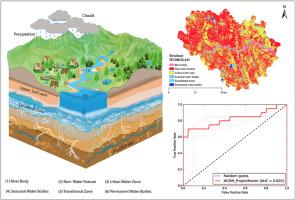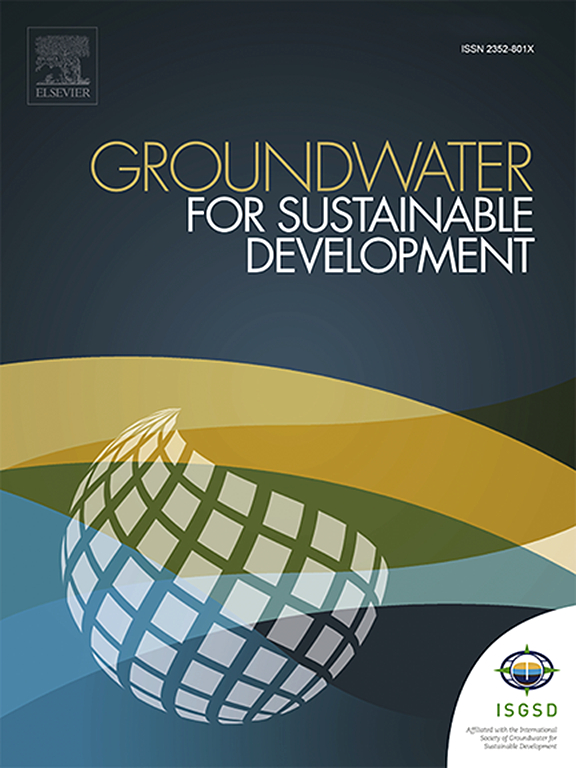Cutting-edge approaches for judging surface water dynamics in semi-arid environments: Integrating landsat 8 OLI/TIRS and HYDROSAM model
IF 4.9
Q2 ENGINEERING, ENVIRONMENTAL
引用次数: 0
Abstract
This research addresses the critical need to assess surface water dynamics in semi-arid regions of Andhra Pradesh, India, by using advanced Spectral Indices for hydrological applications and methodologies. It aims to answer how remote sensing data from Landsat 8 OLI/TIRS can be effectively used to monitor and classify surface water bodies. The study applies indices such as Normalized Difference Water Index (NDWI), Modified Normalized Difference Water Index (MNDWI), Normalized Difference Thermal Index (NDTI), and Water Ratio Index (WRI). Additionally, the Weighted Composite Index (WCI) and Normalized Composite Index (NCI) are integrated with Principal Component Analysis (PCA) for multi-criteria decision making. The HYDROSAM model successfully classifies and maps various categories of surface water bodies, including non-water features (53.62%), urban water zones (37.89%), seasonal water bodies (4.32%), transitional zones (2.17%), permanent water bodies (1.05%), and river bodies (0.95%). The resultant map was validated using the AUC-ROC curve, achieving an AUC of 0.820, indicating a high level of accuracy. This methodology provides a nuanced understanding of water resource distribution and availability in the region. The findings demonstrate the robustness and reliability of the HYDROSAM model in accurately assessing surface water characteristics, thereby providing critical insights for informed water resource management, strategic land-use planning, and effective ecological conservation. This innovative methodology not only fosters sustainable water resource management in semi-arid regions but also sets a precedent for advancing research in similar ecosystems globally.

判断半干旱环境地表水动态的前沿方法:整合陆地卫星 8 OLI/TIRS 和 HYDROSAM 模型
这项研究通过将先进的光谱指数用于水文应用和方法,满足了评估印度安得拉邦半干旱地区地表水动态的迫切需要。研究旨在回答如何有效利用 Landsat 8 OLI/TIRS 遥感数据对地表水体进行监测和分类。研究采用了归一化水差异指数(NDWI)、修正归一化水差异指数(MNDWI)、归一化热差异指数(NDTI)和水比指数(WRI)等指数。此外,加权综合指数(WCI)和归一化综合指数(NCI)还与主成分分析(PCA)相结合,用于多标准决策。HYDROSAM 模型成功地对各类地表水体进行了分类和绘图,包括非水体地貌(53.62%)、城市水区(37.89%)、季节性水体(4.32%)、过渡区(2.17%)、永久性水体(1.05%)和河流水体(0.95%)。利用 AUC-ROC 曲线对所绘制的地图进行了验证,结果 AUC 为 0.820,表明准确度很高。该方法提供了对该地区水资源分布和可用性的细致了解。研究结果证明了 HYDROSAM 模型在准确评估地表水特征方面的稳健性和可靠性,从而为明智的水资源管理、战略性土地利用规划和有效的生态保护提供了重要的见解。这一创新方法不仅促进了半干旱地区水资源的可持续管理,还为推动全球类似生态系统的研究开创了先例。
本文章由计算机程序翻译,如有差异,请以英文原文为准。
求助全文
约1分钟内获得全文
求助全文
来源期刊

Groundwater for Sustainable Development
Social Sciences-Geography, Planning and Development
CiteScore
11.50
自引率
10.20%
发文量
152
期刊介绍:
Groundwater for Sustainable Development is directed to different stakeholders and professionals, including government and non-governmental organizations, international funding agencies, universities, public water institutions, public health and other public/private sector professionals, and other relevant institutions. It is aimed at professionals, academics and students in the fields of disciplines such as: groundwater and its connection to surface hydrology and environment, soil sciences, engineering, ecology, microbiology, atmospheric sciences, analytical chemistry, hydro-engineering, water technology, environmental ethics, economics, public health, policy, as well as social sciences, legal disciplines, or any other area connected with water issues. The objectives of this journal are to facilitate: • The improvement of effective and sustainable management of water resources across the globe. • The improvement of human access to groundwater resources in adequate quantity and good quality. • The meeting of the increasing demand for drinking and irrigation water needed for food security to contribute to a social and economically sound human development. • The creation of a global inter- and multidisciplinary platform and forum to improve our understanding of groundwater resources and to advocate their effective and sustainable management and protection against contamination. • Interdisciplinary information exchange and to stimulate scientific research in the fields of groundwater related sciences and social and health sciences required to achieve the United Nations Millennium Development Goals for sustainable development.
 求助内容:
求助内容: 应助结果提醒方式:
应助结果提醒方式:


